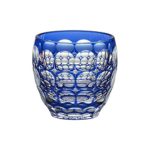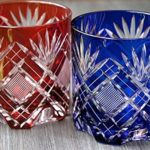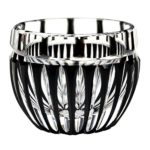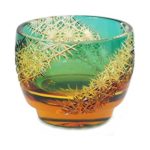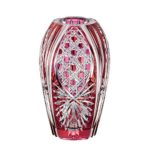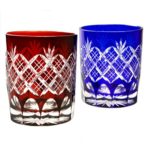Beautiful sake cups and bottles of Edo-kiriko cut glass from Amazon
Yarai Pattern (blue)
There are many traditional crafts including pottery, porcelain, and metal products in Japan but the glassware which has a long history isn’t so many. Edo-kiriko is the most popular Japanese glassware. Edo is the ancient name of Tokyo and more than a million people lived in the city (the largest population in the middle 18the century around the world!). Until the Edo Period (1603-1868), the culture of Japan was mostly developed the ruling class such as aristocracy and samurai. However, the culture of the Edo Period was the culture of townspeople. They like smart and refined things which they called as “粋” (Iki).
Related Post
Do you know how to enjoy sake?
Hishi-nanako Pattern (blue)
As you see, the Edo-kiriko glassware represents the mind of Iki, isn’t it? Actually, when the glassware shopkeeper Kagaya Kyubei began to make cut glass in 1834, the products were only a colorless and transparent crystal glass. The colored cut glass came onto the market during the Meiji Period (1868-1912) when the country accepted the Western culture. The various patterns for Edo-kiriko were also invented in those days. Yarai, Hishi-nanako, and Asa-no ha are the traditional patterns of Edo-kiriko.
Asa-no ha Pattern
Yarai is a palisade. Since a palisade defend against the invasion of enemies, people believed that a sake cup with the pattern has a power to protect from evil. Hishi-nanako means roe pattern in a diamond. A roe pattern is for descendants prosperity. The fine pattern needs the advanced technique of engraving. And Asa-no ha is a hemp leaf which grows up straightly. The pattern contains a wish for the healthy growth.
View more the various patterns of Edo-kiriko glassware
Yarai Pattern (blue)
Especially, the patterns and colors of Edo-kiriko sake cups have increased in these days. I would like you to see them from the links of related posts below!

![Edo Kiriko Japanese Blue Glass Sake Set, Cut Glass Drinking Set Of Sake Decanter & 2 Guinomi Cups [Japanese Crafts Sakura]](https://images-na.ssl-images-amazon.com/images/I/51BvIf17EFL.jpg)




